mobile View, to the German Version tap the flag


- Buryat Republic, Buryatia
- own name: Buryad Respublika
- federal component of the Russian Federation (Russia)
• Flag
• Historical Flags
• Meaning/Origin of the Flag
• Coat of Arms
• Map
• Numbers and Facts
• History
• Origin of the Country's Name
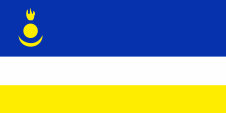
National flag,
ratio = 1:2,
Source, by: UNPO




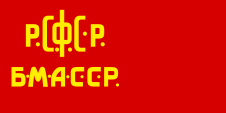
1923–1937,
Flag of the autonomous soviet republic,
ratio = 1:2,
Source, by: World Statesmen



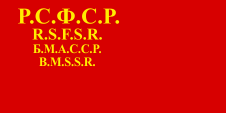
1937–1954,
Flag of the autonomous soviet republic,
ratio = 1:2,
Source, by: World Statesmen



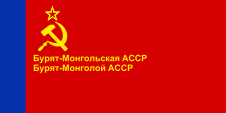
1954–1958,
Flag of the autonomous soviet republic,
ratio = 1:2,
Source, by: World Statesmen



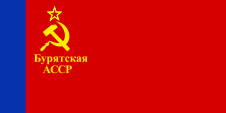
1958–1978,
Flag of the autonomous soviet republic,
ratio = 1:2,
Source, by: World Statesmen



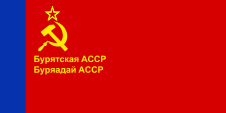
1978–1992,
Flag of the autonomous soviet republic,
ratio = 1:2,
Source, by: World Statesmen



look also:
Flag history of the soviet republics of the USSR

About the origin or the meaning of the flag is nothing known. But the color blue in the flag permits inferences to the nation of the Burjatians, which are named Burjat-Mongols, too. The Burjatians, which name themself Buryat, belong to the Mongol people. Many Mongolians or even Turk people have mutual roots, and as color of their race means blue. This could explain the blue and the soyombo symbol in the on 29th of October in 1992 introduced flag of Burjatia. The flags, which were used in the Soviet era corresponded all to the same pattern as it was intended for the Soviet Autonomous Republics: Between 1923 and 1937 frequently only a single-coloured red bunting with a golden inscription, showing the name of the country. Sometimes only as a shortcut, sometimes the full name, sometimes only in Russian or even multilingual. From about 1937 hammer, sickle and star were sometimes added. From about the mid-50s multicolored flags were introduced for the republics of the Soviet Union, whose knitting patterns had to be taken over by the subordinated autonomous Soviet republics.
Source: Flaggen Enzyklopädie,
Volker Preuß

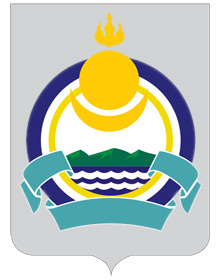
Coat of arms of Buryatia,
Source: Russiatrek

Geographical position within Russia:
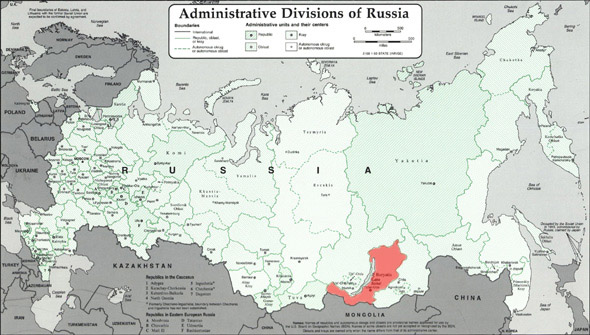
Map: Freeware, russiamap.org, modyfied by: Volker Preuß
enlarge – click here
Map of the country:
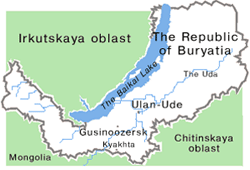
Source:
Russiatrek

Area: 135.650 square miles
Inhabitants: 972.000 (2010), thereof 66% Russian, 30% Buryats
Density of Population: 7 inh./sq.mi.
Capital: Ulan-Ude (to 1934 Werchnje Udinsk), 404.500 inh. (2010)
official Language: Russian
other Languages: Buryatian
Currency: look Russia
Time Zone: GMT + 8 h
Source: Wikipedia (D)

13th cent. · immigration of the Burjatians from Mongolia, in connection with the expansion of the Mongol empire of Genghis Khan
16th cent. · the Mongolian empire collapses
1639 · Russians are coming first in the region
1648 · beginning of permanent settlement by the Russians in the region
1666 · foundation of Verkhnye Udinsk
1689 · signature of Nerchinsky Treaty between Russia and China, where the border is set along the river Argun
1703 · affiliation of the region to the Russian State (Irkutsk Gouvernement)
18th cent. · immigration of Old Believers
1851 · the region east of Lake Baikal is separated from the government of Irkutsk and becomes established as an own reformed region, the Zabaikalskaya Oblast
1917 · Communist Lenin-Coup in Russia, formation of the Buryat National Committee, establishing of the Republic of Buryat-Mongolia with the capital Verkhnye Udinsk
23rd of January 1918 · soviet seizure of power
30th of May in 1923 · foundation of the Autonomous Socialistic Soviet Republic of Burjat-Mongolia
1931 · introduction of the Latin typeface, displacement of the Mongolian spelling
1934 · renaming of Verkhnye Udinsk in Ulan-Ude
1937 · introduction of the Cyrillic typeface
1937 · detachment of the provinces Irkutsk and Chita from Burjatia
1958 · renamed in Buryat-Mongolian Autonomous Soviet Socialist Republic
1970 · interdiction of the Burjatian language in schools
31st of December in 1991 · the Soviet Union dissolves, the constitution of the Russian Socialist Federative Soviet Republic (RSFSR, Russia), a former substate of the Soviet Union, remains in force for the time being
1992 · rename to Buryat Republic
25th of December in 1993 · a new constitution for Russia (Russian Federation) comes into force, and the relationships with the members of the federation is re-regulated in this way
Source:
Atlas zur Geschichte,
World Statesmen,
Russiatrek,
Die Völker der Erde

The name "Buryatia" refers to the people living here, the Buryats..
Source: Die Völker der Erde


![]()






















